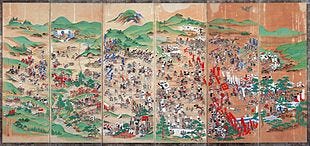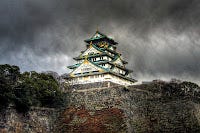Way back in the dark ages (the 1970s) when I was a rabid reader, I devoured the books of James Clavell - all absolute door stoppers that would probably struggle to find publishers these days. SHOGUN was one of these novels. It was made into a TV mini series in 1980 with Richard Chamberlain in the lead role but gradually disappeared from conscious memory.
I am half way through the new incarnation (showing on Disney+ here in Australia) and I am loving it. The attention to detail and historical accuracy is blowing my mind (even though it was filmed in Canada!). So I thought you might be interested in knowing something of the true story behind Clavell’s book and being a student of seventeenth century this is a copy of a post I wrote some years ago.
First some context! The seventeenth century was a time of enormous political and social upheaval. Europe is dominated by the Thirty Years’ War, the English Civil War and years of fighting throughout the continent as France, Spain, England, the Netherlands, the Catholic and Protestant Churches wrestled for power. It was also a time of exploration. The Americas began to be seriously colonised and in the East (as I have written in other blogs), the Dutch, the English and the Spanish wrangled for control over the lucrative spice trade and in this post I would like to introduce you to another revolution...the coming of the Tokigawa Shogunate to Japan.
Ieyasu Tokagawa as Shogun of Japan
At the end of the sixteenth century, Japan had endured nearly two centuries of social upheaval and military conflict as regional war lords (the daimyo) battled for the ultimate control of the country. This period of Japanese history is known as the Sengoku, or “warring state” period. It was into this country torn by war that Ieyasu Tokigawa was born in 1543. Kidnapped by an opposing war lord at the age of six, he spent the next nine years as a hostage. Traded between the warring clans, Ieyasu reached the age of fifteen (the coming of age) in the custody of the Imagawa clan. He married into the clan and went to war against the Oda clan and changed his name to Motayatsu.
The Tokagawa Clan symbol
Recognising brilliance in the new leader of the Oda clan, Oda Nobunagu, Motayatsu pledged his loyalty to Nobunaga. As leader of his own clan of Matdudaira, his military prowess became legendary and the next twenty years were spent in the continuing warfare between the states. During this period he changed his name once more and became Ieyasu Tokagawa.
In 1579 his first son was accused of plotting to assassinate Nobunaga and was forced to commit sepukku. His third and favourite son Tokugawa Hidetade became his heir. (His second son had been adopted by Toyotami Hideyoshi). With the death of Nobunaga, a struggle for supremacy ensued and by 1583, Hideyoshi had prevailed in the struggle and become the single most powerful daimyo in Japan.
Ieyasu had remained neutral during the last part of the struggle but in 1584, he sided with Nobunaga’s son against Hideyoshi. The Battles of Komaki and Nagakute would be the only time these two great leaders Hideyoshi and Ieyasu would face each other as enemies. In fact the campaign proved indecisive and Hideyoshi negotiated peace with Ieyasu and Nobunaga’s son.
In 1590 Hideyoshi conquered the last daimyo in Japan and in a risky move Ieyasu agreed to leave his home provinces and move his power base to Edo (now Tokyo). The move proved a good one and in a few years Ieyasu had consolidated his power base and was second only to Hideyoshi in power. Hideyoshi came to rely more and more upon Ieyasu as one of his principle military advisors.
(And this is where the Clavell story kicks in) In 1598, on his death bed, Hideyoshi, appointed a Council of Five Elders to rule Japan until his son, Hideyori, came of age. Ieyasu was one of these men and in 1599 Ieyasu captured Osaka Castle, home of the young Hideyori. The remaining three regents were ranged against him with a powerful daimyo Ishedo Mitsunaro as their head. Japan was once again plunged into civil war.
The Battle of Sekighara
The Battle of Sekighara (or the Battle of the Sundered Realm) was fought on October 21, 1600. It is one of the most famous battles in Japanese history and worthy of a blog of its own. It was a decisive Takogawa victory. In the next few years, Ieyasu systematically destroyed the power bases of his enemies. Hideyori, the boy king was reduced to the rank of daimyo and all his territory taken from him.
At the age of 60 Tokugawa Ieyasu was given the title of shogun on 24 March1603. Ruling from Edo (now Tokyo) he used his remaining years to create and solidify the shogunate. Officially he abdicated in 1605 in favour of his son Tokugawa Hidetada but he remained the power in Japan until his death 1616. However his last few years were far from peaceful as the usurped Hideyori became the focal point of the disaffected samurai.
Osaka Castle
Takagawa laid siege to Osaka Castle which came to a peacable conclusion but Hideyori refused to honour the treaty and leave the Castle and once again the Tokogawa army settled in for a siege which ended in late 1615 with the fall of the castle and the death of Hideyori and al his family. Only Hideyori’s wife (a granddaughter of Ieyasu) survived.
During his lifetime Ieyasu had an interest in European affairs. In his early years he had negotiated with Spain and Mexico and as the Dutch and English began to take an interest in the Far East, Ieyasu allowed a small presence in Japan. However the European squabbles between Protestant and Catholic flowed into Japan and In 1614, he signed the Christian Expulsion Edict banning Christianity and expelling all Christian and foreigners.
Ieyasu Tokagawa's tomb in Nikko
Ieyasu Tokagawa died in 1616, possibly of syphilis. In his lifetime he had nineteen wives and concubines who gave him eleven sons and five daughters. An educated man, capable of great loyalty and yet utterly ruthless in dealing with anyone who crossed him, he brought peace to a country torn by war and established the Edo shogunate that would last two hundred years.
Entwined with the story of Ieyasu Okagawa, is the story of an Englishman - William Adams - who found himself trapped in Japan and became a close friend and advisor of the Shogun… but that is a story for another day!
In the meantime if you can access Shogun and are prepared for some unrelenting blood, gore and violence (it doesn’t hold back), I highly recommend SHOGUN!
All from me… please feel free to comment directly to the Substack post :-) I love hearing from you.
Best regards
Alison
(This post was originally published on Hoydens and Firebrands)








Wow! This is a superb post. I love reading Japanese history. I’ve been meaning to watch Shogun and now your post has really motivated me :D
Loving (and also looking away when I can) Shogun. I love the intrigue and politics, it's like living inside a game of chess.